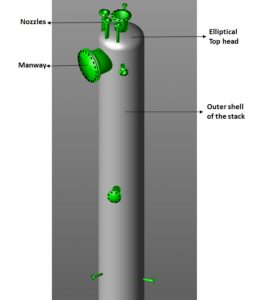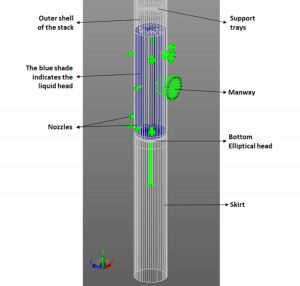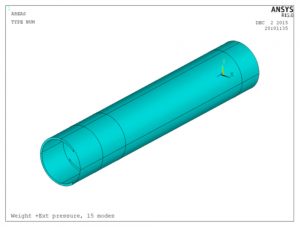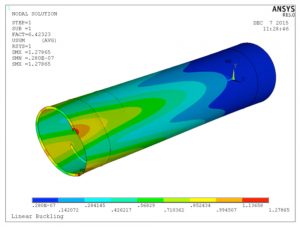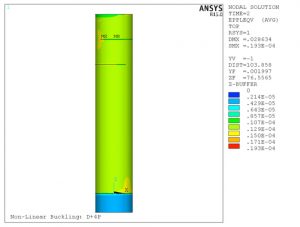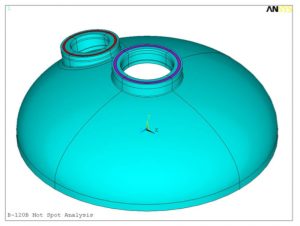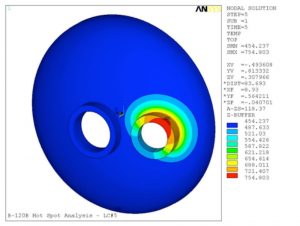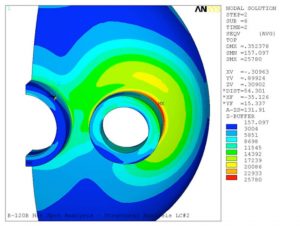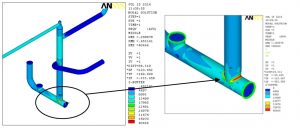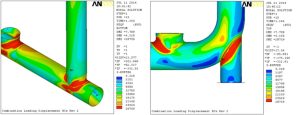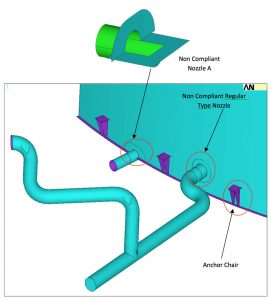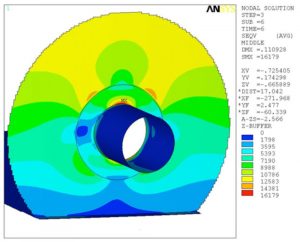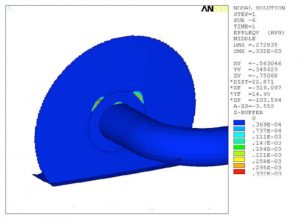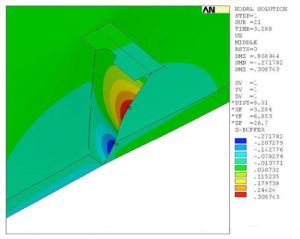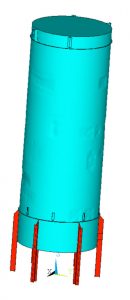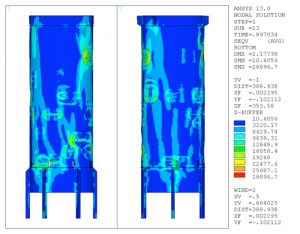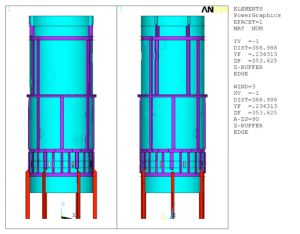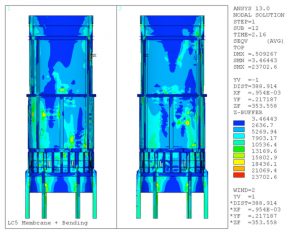Fitness for service and Rerate Calculations of Distillation Column
The scope of the project was to perform Fitness for Service and rerate calculations to analyze the adequacy of a distillation column. Distillation column has been in service for several years. The customer requested for additional corrosion allowance of the distillation column for several more years. Rerate of the distillation column included the shell, the heads, the skirt sections, all the nozzles with corresponding flanges, and the support trays. Calculations included the effect of wind bumpers, platform clips, and pipe supports. The structural adequacy against buckling was verified using Finite Element Analysis (FEA) for the increased corrosion allowance. The determination of structural integrity utilized both Eigen value buckling and nonlinear buckling analyses.
- Top of the distillation column
- Bottom part of the distillation column
- Overview of the model used in buckling analyses
- First buckling mode: The deformation of this model was used in the nonlinear elastic-plastic analysis to determine the adequacy of tray ring supports and the tray ring support to shell weld.
- Von-Mises plastic strain in the column
Hot Spot Analysis
A nozzle and a portion of the vessel head were exposed to a hot spot during methane operations of a gasifier. Although there were no temperature readings at the time of the hot spot formation, the customer estimated the temperature of the hot spot region to be ~ 603°F based on the paint discoloration at the hot spot location. Thermal Finite Element Analyses (FEA) was performed in order to determine the temperature gradients between the hot spot and the rest of the model in the meridian directions, through the thickness of the head, and the corresponding nozzles. The resulting temperature profiles were used in the structural FEA to determine the formation of residual stress in the model and to verify the adequacy of the nozzles, nozzle junctions, and the head for future operation of the gasifier. The analyses were performed per API 579-1/ASME FFS-1.
The customer performed Non-Destructive Examination (NDE) to ensure there were no permanent deformations, cracks, or material deterioration at the vicinity of the hot spot.
- Geometry of the Head and Nozzle Penetrations
- Temperature Distribution Analysis on Nozzle
- Von Mises Stress Level on Nozzle
Distilling Piping Fitness For Service Analysis
Fitness for Service (FFS) analyses were performed on a portion of Distilling Piping utilizing Finite Element Analysis (FEA). A model of the piping system was created using shell elements. The boundary conditions obtained from Caesar II piping analysis for the remainder of the piping system were applied to the termination points of the finite element model. The structural integrity of the piping, under the operating conditions, was verified by performing FEA per API 579-1/ASME FFS-1.
- Pipe Layout for Distillation Piping
- Von Mises Stress per Finite Element Analysis
- Von Mises Stresses per Finite Element Analysis
Fitness For Service of a Tank Nozzle
The customer had several tanks that did not comply with API 650. A Fitness for Service (FFS) was performed using Finite Element Analysis with the load combinations mandated by API 579-1/ASME FFS-1, Table B1.2. The FFS included the linear and limit load analyses for the nozzles. Non-linear buckling analysis was performed to determine the adequacy of the anchor chair gusset plates under wind/seismic forces.
- Tank with Nozzle Layout
- Linear Analysis: von Mises Stress around Nozzle A
- Linear Analysis: von Mises Stress around Regular Type Nozzle
- Limit Load Analysis: Von Mises Plastic Strain around Regular Type Nozzle
- Non Linear Anchor Chair Gusset Buckling Analysis
Fitness for Service/Repair for Vertical Heater
The scope of the analysis was to perform Fitness For Service (FFS) analyses and to provide a repair plan for a vertical heater. The heater shell had reduced thicknesses and severe deformation along the longitudinal and the circumferential directions (dents, gouges, and misalignments). The analyses were to consider the deformed geometry and the reduced shell thicknesses. The analyses utilized the loading prescribed by the customer, including the increased weight due to modification of the convection section. Modifications to the convection box section and the stack positioned on the top of the heater resulted in an increased weight of the convection section.
Fitness For Service analyses were performed to study the structural integrity of the heater for the current condition per API 579-1. Based on the results of these analyses, structural members were added to the model, and the new design was analyzed by performing Fitness For Service analyses under the operating conditions, including the exposure of the heater to the wind loading from several directions. Thermal analyses were performed for various conditions to verify the structural integrity of the new design. Due to the time constraint, the customer was unable to complete the attachment weld of all the structural members to the shell before the repairs to the vertical radiant coils were completed. Therefore, the minimum required weld length for the structural members was determined considering a maximum wind speed of 45 MPH.
- Geometry of the Initial State of the Heater as Measured by the Customer
- Membrane + Bending Stress for LC 1 – South View and North View
- New Design with Reinforcing Structural Members
- Membrane + Bending Stress for the New Design – South View and North View

